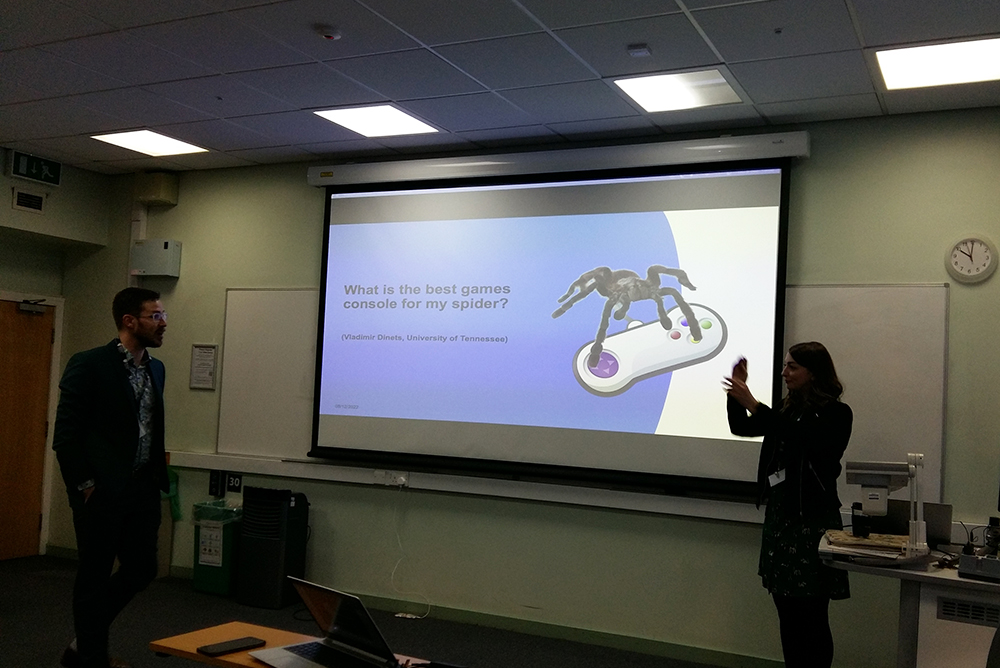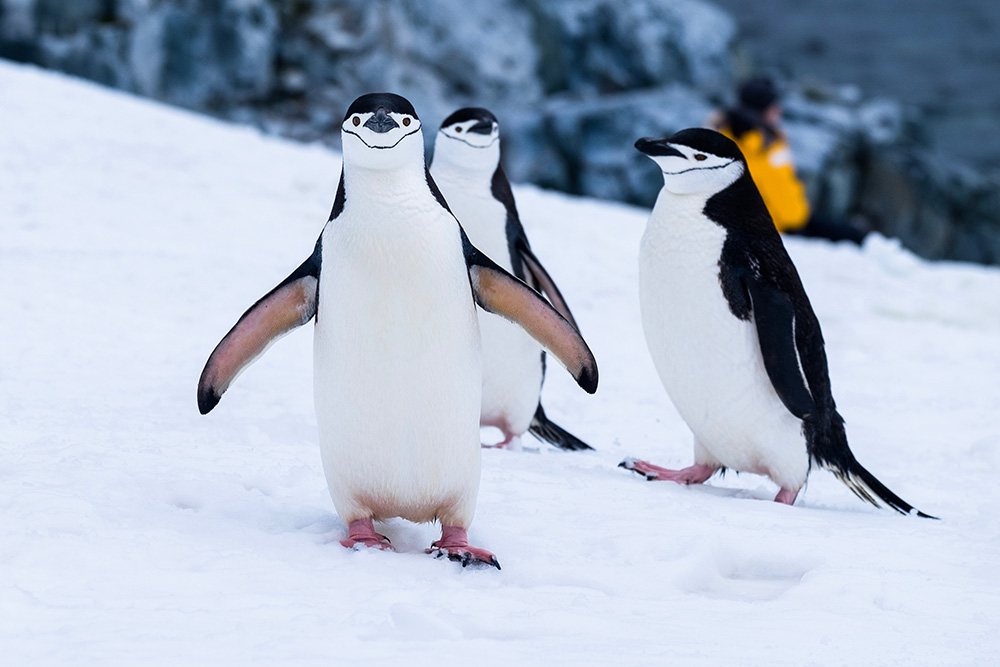The fourth day of the ACI2022 conference – December 8, 2022 – began with a keynote by Carys L. Williams (DogsTrust), titled “Time Savers or Toys? Realities of Animal Technology in Industry”. “Carys is a mixed-methods Research Officer at the UK’s largest dog welfare charity, Dogs Trust. Carys’ work has focused on practical and applicable dog behaviour and welfare research to improve the lives of dogs, especially those in Dogs Trust’s 22 rehoming centres (around 12,000 dogs a year!). For the last 2 years Carys has been project lead for the Dogs Trust Post Adoption Support longitudinal research project. She has additionally supported the charity’s move to collect more and better dog data, helping build exciting bespoke digital systems. Carys has also spent over a decade in the zoo industry and is currently a volunteer invertebrate keeper at ZSL London Zoo.” (Website ACI2022) Carys L. Williams started her keynote with a quote from Vladimir Dinets (University of Tennessee): “What is the best games console for my spider?” … She then turned to real-world issues, such as supporting the welfare of dogs through technological means. More information on the conference via www.aciconf.org/aci2022.
About Parrots and Dogs
The ACI2022 conference continued on the afternoon of December 7, 2022 after the coffee break (“Paper Session 3: Learning From and With Each Other”). Cristóbal Sepulveda Álvarez (Universidad de Chile) gave a talk on the topic “Measuring Digitally Comparative Abilities Between Discreet and Continuous Quantities through a Digital Enrichment Application”. He showed a parrot that had to choose different quantities on a touch screen. Dirk van der Linden (Northumbria University) was present on behalf of Jasmine Forester-Owen (Northumbria University). He spoke about “Noisy technology, anxious dogs: can technology support caregiving in the home?”. In their prototype, they combine noise detection and body language identification in dogs. Jérémy Barbay (Universidad de Chile) gave the last three presentations of the day: “Comparing Symbolic and Numerical Counting Times between Humans and Non-Humans Through a Digital Life Enrichment Application”, “Popping Up Balloons for Science: a Research Proposal”, and “A Loggable Aid to Speech (for Human and Non-Human Animals): A Research Proposal”. More information on the conference via www.aciconf.org.
Towards Exploring Perceptions of Dogs
The ACI2022 conference continued on the afternoon of December 7, 2022. “Paper Session 2: Recognising Animals & Animal Behaviour” began with a presentation by Anna Zamansky (University of Haifa). The title was “How Can Technology Support Dog Shelters in Behavioral Assessment: an Exploratory Study”. Her next talk was also about dogs: “Do AI Models ‘Like’ Black Dogs? Towards Exploring Perceptions of Dogs with Vision-Language Models”. She went into detail about OpenAI’s CLIP model, among other things. CLIP is a neural network which learns visual concepts from natural language supervision. She raised the question: “How can we use CLIP to investigate adoptability?” Hugo Jair Escalante (INAOE) then gave a presentation on the topic “Dog emotion recognition from images in the wild: DEBIw dataset and first results”. Emotion recognition using face recognition is still in its infancy with respect to animals, but impressive progress is already being made. The last presentation in the afternoon before the coffee break was “Detecting Canine Mastication: A Wearable Approach” by Charles Ramey (Georgia Institute of Technology). He raised the question: “Can automatic chewing detection measure how detection canines are coping with stress?”. More information on the conference via www.aciconf.org.
About Animal-centered Design
ACI2022 continued on December 7 with Paper Sessions. Number 1 was “Designing for Human-Animal Relations”. Clara Mancini from The Open University gave a talk on the topic “Politicising Animal-Computer Interaction: an Approach to Political Engagement with Animal-Centred Design”. She is one of the pioneers in the discipline of animal-computer interaction. This was followed by Dirk van der Linden’s presentation “Animal-centered design needs dignity: a critical essay on ACI’s core concept”. The scientist from the Northumbria University referred to the Swiss law, which assumes the dignity of living beings – animals as well as plants, it should be added. Minori Tsuji from Future University Hakodate spoke about the “Investigation on Enhancement of the Sense of Life in Safari Park Online Tours with Animal Breathing Reproduction System”. Visitors can touch artifacts with different breathing frequencies. The final contribution in the morning came from Jennifer Cunha (Parrot Kindergarten) and Corinne Renguette (Indiana University-Purdue University). It was about “A Framework for Training Animals to Use Touchscreen Devices for Discrimination Tasks”. The scientists taught various animals, such as a parrot, a rat and a dog, how to use tablets. More information on the conference via www.aciconf.org.
Exploring other Sensibilities
ACI2022 – the leading conference on animal-computer interaction – kicked off on December 5, 2022 at Northumbria University in Newcastle upon Tyne. After the workshop “Animal Centered Research beyond ACI: Exploring the Applicability of Animal Centered Principles to All Animal Research” was held on the first day, the workshop “Exploring other sensibilities – beyond human senses and aesthetics” was held on the second day. “This workshop aims to facilitate human participants to become more aware of other animals’ sensory and aesthetic sensibilities, raising points for discussion and future research within ACI. For all animals, being able to make sense of the environment is crucial in order to gain control and make informed choices, as well as to achieve competence in daily activities. Although human perception is limited by evolution, technology can enable us to perceive signals that may be meaningful for other species, thereby gaining insight and possibly empathy. Moreover, pursuing a multi-species perspective may foster inclusive approaches to design that aim to achieve a lighter environmental impact by taking into account the sensory experiences of other species.” (Website ACI2022) The workshop used innovative methods to achieve the goal. “We will offer participants a range of activities to challenge human senses and sense-making abilities, and then invite them to collaboratively design and test a system that incorporates some animal-centred sensory stimulation inspired by the activities previously undertaken.” (Website ACI2022) The participants mastered the tasks with great commitment and great pleasure. The entire conference program is available at www.aciconf.org/conference-program.
Accepted Papers of ACI’22
The conference program for ACI’22 will be available in the course of November. In the meantime, the website lists the accepted papers in alphabetical order. Among them are the papers “A Face Recognition System for Bears: Protection for Animals and Humans in the Alps” (Oliver Bendel and Ali Yürekkirmaz), “A Framework for Training Animals to Use Touchscreen Devices for Discrimination Tasks” (Jennifer Cunha and Corinne Renguette), “Politicising Animal-Computer Interaction: an Approach to Political Engagement with Animal-Centred Design” (Clara Mancini, Orit Hirsch-Matsioulas, and Daniel Metcalfe), and “TamagoPhone: A framework for augmenting artificial incubators to enable vocal interaction between bird parents and eggs” (Rebecca Kleinberger, Megha Vemuri, Janelle Sands, Harpreet Sareen, Janet M. Baker). ACI2022 will take place 5-8 December 2022, hosted by Northumbria University, Newcastle upon Tyne, UK.
Defining Tomorrow
Animal-computer interaction (ACI) “is a rapidly growing field, which focuses on the interaction between animals and computing-enabled technology and for which the International Conference on Animal-Computer Interaction is the main convention venue” (Website ACI2022). ACI2022 will take place 5-8 December 2022, hosted by Northumbria University, Newcastle upon Tyne, UK. The “Emerging Work” track reflects early stage efforts that either: “1) will be of interest to the ACI community and likely to generate insightful, instructional, and/or spirited discussion, and/or 2) is early enough that it could benefit greatly from community feedback on direction, design, methods, etc.” (Website ACI2022) In this track, the paper “A Face Recognition System for Bears: Protection for Animals and Humans in the Alps” by Oliver Bendel and Ali Yürekkirmaz was accepted. It fits very well with this year’s conference theme, “Defining Tomorrow”. “The theme acknowledges the rapid growth in technology for animals with new products coming onto the market, normalising the use of technology in many human-animal relationships, and asks: where should we go next?” (Website ACI2022)
AI Ethics and Animals
The impact of robotics and artificial intelligence on non-human animals has been researched by Oliver Bendel for several years. He has made it his task to complement the discipline of animal-computer interaction, which was founded by Clara Mancini, with the discipline of animal-machine interaction. His most recent paper is “Passive, Active, and Proactive Systems and Machines for the Protection and Preservation of Animals and Animal Species”, published February 25, 2022, in Frontiers of Animal Science. Also becoming active in this field now is the famous ethicist Peter Singer. Together with his co-author Yip Fai Tse, he published the article “AI ethics: the case for including animals” in July 2022. From the abstract: “The ethics of artificial intelligence, or AI ethics, is a rapidly growing field, and rightly so. While the range of issues and groups of stakeholders concerned by the field of AI ethics is expanding, with speculation about whether it extends even to the machines themselves, there is a group of sentient beings who are also affected by AI, but are rarely mentioned within the field of AI ethics – the nonhuman animals. This paper seeks to explore the kinds of impact AI has on nonhuman animals, the severity of these impacts, and their moral implications. We hope that this paper will facilitate the development of a new field of philosophical and technical research regarding the impacts of AI on animals, namely, the ethics of AI as it affects nonhuman animals.” (Peter Singer and Yip Fai Tse 2022) In the text, the authors write: “Of the hundreds of AI ethics related papers we reviewed in this project, we only found four that concern the impacts of AI on animals, in a general way, and discuss the relevant ethical implications. They are: ‘Towards animal-friendly machines’ by Oliver Bendel, ‘AI Ethics and Value Alignment for Nonhuman Animals’ by Soenke Ziesche, ‘Moral Consideration of Nonhumans in the Ethics of Artificial Intelligence’ by Andrea Owe and Seth Baum and ‘Animals and AI. The role of animals in AI research and application – An overview and ethical evaluation’ by Leonie Bossert and Thilo Hagendorf.” (Peter Singer and Yip Fai Tse 2022) The article will certainly give the young disciplines a further boost.
A Robot Among Penguins
British Filmmaker John Downer has created artificial monkeys, wolves, hippos, turtles, alligators, etc., to observe appropriate wildlife and obtain spectacular images. His well-known robots are very intricately designed and resemble the animals they mimic in almost every detail. It is not necessary to resort to such technically elaborate and artistically demanding means for all species. USA Today reports in a recent article about a robot called ECHO. “ECHO is a remote-controlled ground robot that silently spies on the emperor penguin colony in Atka Bay. The robot is being monitored by the Single Penguin Observation and Tracking observatory. Both the SPOT observatory, which is also remote-operated through a satellite link, and the ECHO robot capture photographs and videos of animal population in the Arctic.” (USA Today, May 6, 2022) ECHO does not resemble a penguin in any way. It is a yellow vehicle with four thick wheels. But as a video shows, the animals seem to have gotten used to it. It comes very close to them without scaring them. Wildlife monitoring using robots is becoming increasingly important, and obviously very different types are being considered.
Machines and Robots for Animal Welfare
On 25 February 2022, the article “Passive, Active, and Proactive Systems and Machines for the Protection and Preservation of Animals and Animal Species” by Oliver Bendel was published in Frontiers in Animal Science. From the abstract: “Digitalization and automation are expanding into many areas, resulting in more widespread use of partially and fully autonomous machines and robots. At the same time, environmental and other crises and disasters are on the rise, the world population is growing, and animals are losing their habitat. Increasingly, machines and robots such as agricultural vehicles, autonomous cars, robotic lawnmowers, or social robots are encountering animals of all kinds. In the process, the latter are injured or killed. Some machines can be designed so that this does not happen. Relevant disciplines and research areas briefly introduced here are machine ethics, social robotics, animal-machine interaction, and animal-computer interaction. In addition, animal welfare is important. Passive and active machines—as they are called in this review—are already appearing and help to observe and protect animals. Proactive machines may play a role in the future. They could use the possibilities of full automation and autonomy to save animals from suffering in agriculture or in the wild. During crises and disasters and in extensive nature reserves, they could observe, care for, and protect animals. The review provides initial considerations on active, passive, and proactive machines and how they can be used in an animal preservation context while bearing in mind recent technical and global developments.” The article is part of the research topic “Animal-Computer Interaction and Beyond: The Benefits of Animal-Centered Research and Design” and can be accessed at www.frontiersin.org/articles/10.3389/fanim.2022.834634/full.









